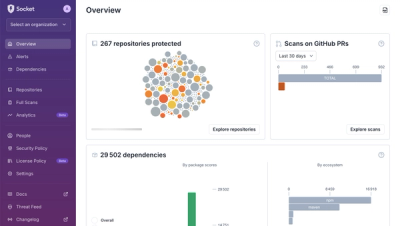
Research
wget to Wipeout: Malicious Go Modules Fetch Destructive Payload
Socket's research uncovers three dangerous Go modules that contain obfuscated disk-wiping malware, threatening complete data loss.
redux-responsive
Advanced tools
Utilities for easily creating responsive designs in a redux architecture.
A redux reducer for managing the responsive state of your application.
// MyComponent.js
import React from 'react'
import {connect} from 'react-redux'
// grab only the responsive state from the store
// (assuming you have put the `responsiveStateReducer` under
// the key `browser` in your state tree)
function browserSelector({browser}) {
return {browser}
}
@connect(browserSelector)
class MyComponent extends React.Component {
render() {
// grab the responsive state off of props
const {browser} = this.props
let message = `The viewport's current media type is: ${browser.mediaType}.`
if (browser.lessThan.small) {
message += 'Secret message for viewports smaller than than the "small" breakpoint!'
} else if (browser.lessThan.medium) {
message += 'Secret message for viewports between the "small" and "medium" breakpoints!'
} else {
message += 'Message for viewports greater than the "medium" breakpoint.'
}
return (
<p>
{message}
</p>
)
}
}
redux-responsive does not require that you use React as your view library. However, since that is what is commonly used alongside redux, this documentation employs common React patterns.
There are many solutions for cleanly handling responsive designs in React applications. One common approach is to wrap a component in another component which is responsible for handling the behavior and passing the information down as a prop. While this at first seems good and the "react way", as the behavior gets more complicated, this quickly leads to a lot of boilerplate code in a single component. Also, depending on the implementation, it is possible that many copies of the responsive wrapper would create many different resize handlers.
Using a specialized store not only reduces the overall noise in a component, but also guarantees that only a single event listener is listening for resize.
First, add the reducer to the root of your reducer tree (you can name it whatever you want).
// reducer.js
import {combineReducers} from 'redux'
import {responsiveStateReducer} from 'redux-responsive'
export default combineReducers({
browser: responsiveStateReducer,
})
Second, you must add required event handlers to keep the responsive state up to date. redux-responsive uses
MediaQueryLists to efficiently update the
store only when required. To do this, use the provided store enhancer.
// store.js
import {createStore} from 'redux'
import {responsiveStoreEnhancer} from 'redux-responsive'
import reducer from './reducer'
const store = createStore(reducer, responsiveStoreEnhancer)
// or, if you have an initial state for the store
const store = createStore(reducer, initialState, responsiveStoreEnhancer)
export default store
Note that if you are also using some middlewares, the call will look more like this:
import {createStore, applyMiddleware, compose} from 'redux'
import {responsiveStoreEnhancer} from 'redux-responsive'
import reducer from './reducer'
const store = createStore(
reducer,
compose(
responsiveStoreEnhancer,
applyMiddleware(middleware1, middleware2)
)
)
// or, if you have an initial state for the store
const store = createStore(
reducer,
initialState,
compose(
responsiveStoreEnhancer,
applyMiddleware(middleware1, middleware2)
)
)
export default store
Now your store is ready to use. The store's default breakpoints match common device sizes and are accessible by the following names in your view:
const defaultBreakpoints = {
extraSmall: 480,
small: 768,
medium: 992,
large: 1200,
}
The responsiveStateReducer (and the reducer returned by createResponsiveStateReducer) adds an object with the following keys to the store:
mediaType: (string) The largest breakpoint category that the browser satisfies.orientation: (string) The browser orientation. Has three possible values: "portrait", "landscape", or null.lessThan: (object) An object of booleans that indicate whether the browser is currently less than a particular breakpoint.greaterThan: (object) An object of booleans that indicate whether the browser is currently greater than a particular breakpoint.is: (object) An object of booleans that indicate whether the browser is current that particular breakpoint.For example, if you put the responsive state under the key browser (as is done in the examples above) then you can access the browser's width and current media type, and determine if the browser is wider than the medium breakpoint like so
// get the current state from the store
const state = store.getState()
// browser media type (e.g. "large")
state.browser.mediaType
// browser orientation (takes a null value on desktops)
state.browser.orientation
// true if browser width is greater than the "medium" breakpoint
state.browser.greaterThan.medium
// true if browser.mediaType === 'small'
state.browser.is.small
You can also create your own reducer based on custom breakpoints:
// reducer.js
import {combineReducers} from 'redux'
import {createResponsiveStateReducer} from 'redux-responsive'
export default combineReducers({
browser: createResponsiveStateReducer({
extraSmall: 500,
small: 700,
medium: 1000,
large: 1280,
extraLarge: 1400,
}),
})
When the browser is wider than the largest breakpoint, it's mediaType value is infinity. In order to
change this value, add the infinity field to the object pass as a second argument to createResponsiveStateReducer:
// reducer.js
import {combineReducers} from 'redux'
import {createResponsiveStateReducer} from 'redux-responsive'
export default combineReducers({
// passing null to the reducer factory uses the default breakpoints
browser: createResponsiveStateReducer(null, {
infinity: "veryBig"
})
})
In some cases, you may want to add computed fields to the responsive state. For example,
an application may frequently need to know when the browser is greaterThanOrEqual to
a particular breakpoint. In order to support this, redux-responsive lets you pass a
function and to createResponsiveStateReducer arguments as the extraFields key.
This function will recieve an object with the responsive state and returns an object
with the new keys to be injected into the state whenever it is recalculated:
// reducer.js
import {combineReducers} from 'redux'
import {createResponsiveStateReducer} from 'redux-responsive'
import {transform} from 'lodash'
export default combineReducers({
browser: createResponsiveStateReducer(null, {
extraFields: ({ greaterThan, is }) => ({
// greaterThanOrEqual is built by transforming greaterThan
greaterThanOrEqual: transform(greaterThan, (result, value, mediaType) => {
// and combining the value with the `is` field
result[mediaType] = value || is[mediaType]
}, {})
}),
})
})
In some cases, you may want to have a window attributes tracked in your responsive state (for example, width).
To accomplish this, the first step is to add the custom field as described above.
// reducer.js
import {combineReducers} from 'redux'
import {createResponsiveStateReducer} from 'redux-responsive'
import {transform} from 'lodash'
export default combineReducers({
browser: createResponsiveStateReducer(null, {
extraFields: () => ({
width: window.innerWidth
}),
})
})
When doing this, keep in mind that the responsive state enhancer only causes the responsive state to be recalculated when the browser actually transitions between states. It does not recalculate on every resize. Therefore, you might also need to add an event handler that recalculates the state at another time:
// store.js
import {calculateResponsiveState} from 'redux-responsive'
const store = ...
window.addEventListener('resize', () => store.dispatch(calculateResponsiveState(window)))
Isomorphic applications must make sure that the sever-rendered markup matches the
DOM rendered by the client. Setting the calculateInitialState option in the
createResponsiveStoreEnhancer factory method to false tells the reducer
to skip the initial responsive state calculation. The responsive state will
contain the default values on both the server and the client side.
// store/configureStore.js
import {createStore} from 'redux'
import {createResponsiveStoreEnhancer} from 'redux-responsive'
import reducer from './reducer'
const store = createStore(
reducer,
createResponsiveStoreEnhancer({calculateInitialState: false}))
export default store
The application should explicitly dispatch the action to recalculate the responsive state when the application is rendered by the client.
// client.js
// external imports
import ReactDOM from 'react-dom'
import {calculateResponsiveState} from 'redux-responsive'
// local imports
import store from 'path/to/store'
// render the application
ReactDOM.render(
<Provider store={store}>
// ...
</Provider>,
document.getElementById('app')
)
// calculate the initial state
store.dispatch(calculateResponsiveState(window))
If you know the initial media type for your application (by doing something like looking at
the user-agent) you can set the initial media type with the initialMediaType key to the
reducer factory:
const reducer = createResponsiveStateReducer(null, {initialMediaType: 'small'})
When building responsive applications in react, it's common to implement styles for each breakpoint and then apply them like so:
const commonStyle = {...}
const styles = {
element: {
...commonStyle,
color: 'blue',
},
elementThin: {
...commonStyle,
color: 'black',
}
}
// somewhere in your component...
<div style={browser.lessThan.medium ? styles.elementThin : styles.element} />
However this becomes very repetitive rather quickly. To help, redux-responsive
provides a higher-order component for managing these styles. The StyleSheet
higher-order component takes a function of two arguments, the current state of the
responsive reducer, and any props passed to the component. The follow is
equivalent to the logic above:
import {StyleSheet} from 'redux-responsive/react'
const stylesheet = (browser, props) => ({
element: {
color: 'blue',
_lessThan_medium: {
color: 'black',
}
}
})
const component = StyleSheet(stylesheet)(({styles}) => (
<div style={styles.element} />
))
This library supports using redux-immutable to make the root of your state an Immutable.js Map or Record.
However, transforming the branch of state managed by redux-responsive into Immutable data is not supported, because the redux-responsive reducer expects vanilla JS. Please keep this in mind if you're using SSR and transforming your state before hydrating.
redux-responsive is returning the wrong breakpoint on mobile devices, what may be causing this?
This may be caused by not having the
<meta name="viewport">tag in the head of your HTML. Adding this code may resolve your issue:<meta name="viewport" content="width=device-width, height=device-height, initial-scale=1.0, minimum-scale=1.0">. Read more here on how it works.
Semver is followed as closely as possible. For updates and migration instructions, see the changelog.
FAQs
Utilities for easily creating responsive designs in a redux architecture.
The npm package redux-responsive receives a total of 11,372 weekly downloads. As such, redux-responsive popularity was classified as popular.
We found that redux-responsive demonstrated a not healthy version release cadence and project activity because the last version was released a year ago. It has 1 open source maintainer collaborating on the project.
Did you know?

Socket for GitHub automatically highlights issues in each pull request and monitors the health of all your open source dependencies. Discover the contents of your packages and block harmful activity before you install or update your dependencies.

Research
Socket's research uncovers three dangerous Go modules that contain obfuscated disk-wiping malware, threatening complete data loss.

Research
Socket uncovers malicious packages on PyPI using Gmail's SMTP protocol for command and control (C2) to exfiltrate data and execute commands.

Product
We redesigned Socket's first logged-in page to display rich and insightful visualizations about your repositories protected against supply chain threats.